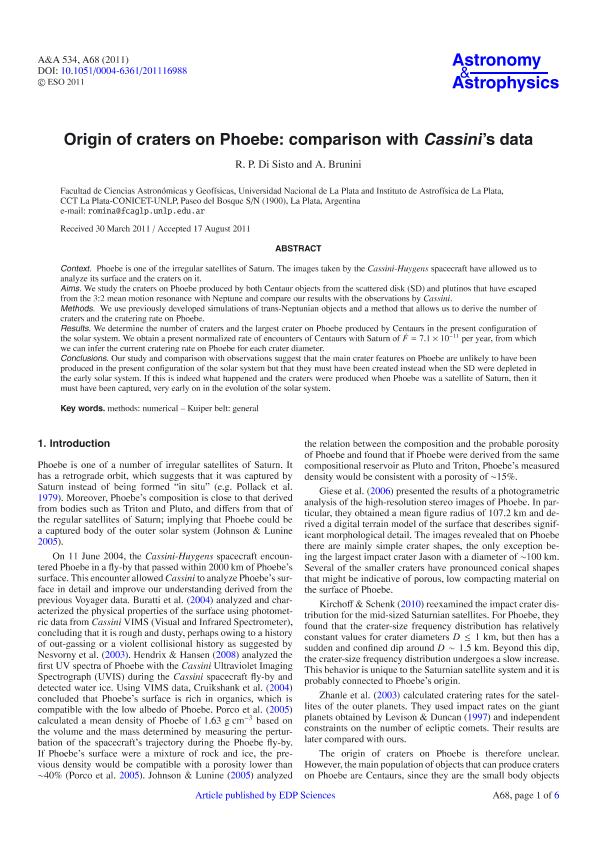Mostrar el registro sencillo del ítem
dc.contributor.author
Di Sisto, Romina Paula

dc.contributor.author
Brunini, Adrian

dc.date.available
2016-12-15T21:56:53Z
dc.date.issued
2011-10
dc.identifier.citation
Di Sisto, Romina Paula; Brunini, Adrian; Origin of craters on Phoebe: comparison with Cassini’s data; Edp Sciences; Astronomy And Astrophysics; 534; 10-2011; 1-6
dc.identifier.issn
0004-6361
dc.identifier.uri
http://hdl.handle.net/11336/9556
dc.description.abstract
Context: Phoebe is one of the irregular satellites of Saturn. The images taken by the Cassini-Huygens spacecraft have allowed us to analyze its surface and the craters on it.
Aims: We study the craters on Phoebe produced by both Centaur objects from the scattered disk (SD) and plutinos that have escaped from the 3:2 mean motion resonance with Neptune and compare our results with the observations by Cassini.
Methods: We use previously developed simulations of trans-Neptunian objects and a method that allows us to derive the number of craters and the cratering rate on Phoebe.
Results: We determine the number of craters and the largest crater on Phoebe produced by Centaurs in the present configuration of the solar system. We obtain a present normalized rate of encounters of Centaurs with Saturn of F˙ = 7.1 × 10−11 per year, from which we can infer the current cratering rate on Phoebe for each crater diameter.
Conclusions: Our study and comparison with observations suggest that the main crater features on Phoebe are unlikely to have been produced in the present configuration of the solar system but that they must have been created instead when the SD were depleted in the early solar system. If this is indeed what happened and the craters were produced when Phoebe was a satellite of Saturn, then it must have been captured, very early on in the evolution of the solar system.
dc.format
application/pdf
dc.language.iso
eng
dc.publisher
Edp Sciences

dc.rights
info:eu-repo/semantics/openAccess
dc.rights.uri
https://creativecommons.org/licenses/by-nc-sa/2.5/ar/
dc.subject
Method
dc.subject
Numerical
dc.subject
Kuiper
dc.subject
Belt
dc.subject.classification
Astronomía

dc.subject.classification
Ciencias Físicas

dc.subject.classification
CIENCIAS NATURALES Y EXACTAS

dc.title
Origin of craters on Phoebe: comparison with Cassini’s data
dc.type
info:eu-repo/semantics/article
dc.type
info:ar-repo/semantics/artículo
dc.type
info:eu-repo/semantics/publishedVersion
dc.date.updated
2016-12-14T12:55:37Z
dc.journal.volume
534
dc.journal.pagination
1-6
dc.journal.pais
Francia

dc.description.fil
Fil: Di Sisto, Romina Paula. Universidad Nacional de la Plata. Facultad de Ciencias Astronómicas y Geofísicas; Argentina. Consejo Nacional de Investigaciones Científicas y Técnicas. Centro Científico Tecnológico La Plata. Instituto de Astrofísica de La Plata; Argentina
dc.description.fil
Fil: Brunini, Adrian. Consejo Nacional de Investigaciones Científicas y Técnicas. Centro Científico Tecnológico la Plata. Instituto de Astrofísica de la Plata; Argentina. Universidad Nacional de la Plata. Facultad de Ciencias Astronómicas y Geofísicas; Argentina
dc.journal.title
Astronomy And Astrophysics

dc.relation.alternativeid
info:eu-repo/semantics/altIdentifier/url/http://www.aanda.org/index.php?option=com_article&access=doi&doi=10.1051/0004-6361/201116988&Itemid=129
dc.relation.alternativeid
info:eu-repo/semantics/altIdentifier/doi/http://dx.doi.org/10.1051/0004-6361/201116988
dc.relation.alternativeid
info:eu-repo/semantics/altIdentifier/url/https://arxiv.org/abs/1108.3808
Archivos asociados
